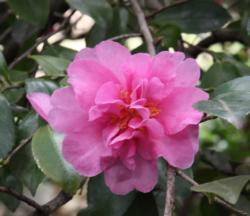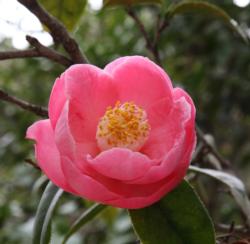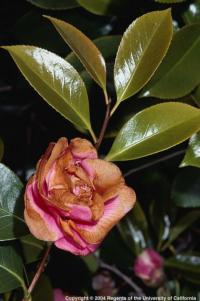Shrub- Camellias
-
Camellias are evergreen shrubs or small trees with shiny green leaves and beautiful, colorful blossoms. They are native to eastern and southern Asia, but have been grown in Europe and the US since the 1700's. The most commonly grown variety in the home garden is probably Camellia japonica, but many other varieties are also available.

Their blooming season in California varies by variety, and can be early (October-January), mid-season (January-February) or late season(March - April). Blossoms can range in size from miniature (21/2 inches or less) to large (4-5 inches or greater); there are 6 basic flower forms depending on how many rows or layers of petals, as well as other features of the blossoms.

Planting
Camellias are generally planted in the winter months in southern California. They require rich, acidic soil with excellent drainage. They should be planted so the crown is above the soil level and with a 2 inch layer of mulch to protect the roots. Camellias can also be grown in containers using slightly acidic soil supplemented with organic material (peat moss or compost) and pumice or vermiculite for drainage.Fertilization
Fertilize camellias about 3 times per year with a balanced acid fertilizer.
Irrigation
Water camellias regularly so that the soil remains moist to 12-14 inches deep, but never soggy. Established plants require less frequent irrigation than young plants or plants in containers.
Common ProblemsCamellias are not prone to many problems if given the proper environment and care. Shady exposure and rich, well draining soil keep them happy. Here's a guide to common problems with camellias which gives specific information about how to recognize the problem and solutions to manage it.
Petal and flower blightCamellia petal blight is a fungal disease that causes blossoms to turn brown and rot and the blossoms to drop prematurely. This disease is worse when the weather is rainy.
Solutions
Avoid overhead irrigation of the plant. Apply a 4 inch deep mulch layer of organic mulch beneath plants to reduce fungal spore survival. Do not add camellia petals or leaves to any compost that will be used around camellias, as the spores will not be killed during the composting process and will grow when the compost is spread. Reapply a fresh layer of organic mulch on top of existing mulch beneath plants every year after the blooming season. Avoid moving or disturbing the existing mulch beneath plants since fungal spores may have settled into the mulch. Pick off and dispose of all blighted blossoms.
Read more about camellia petal and flower blight.



